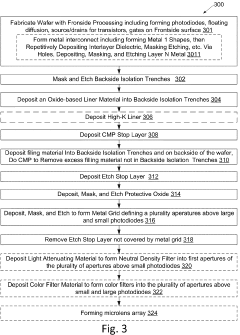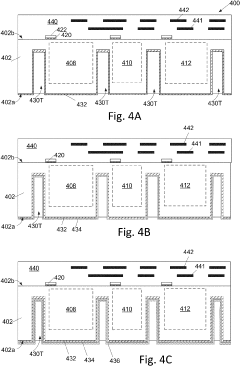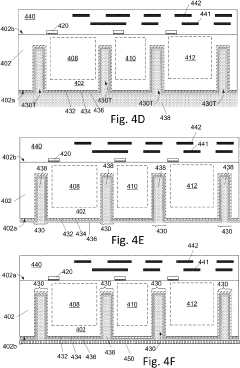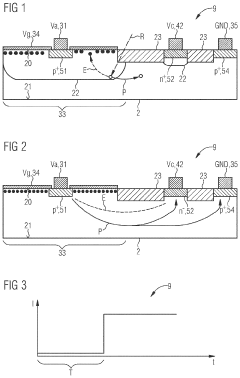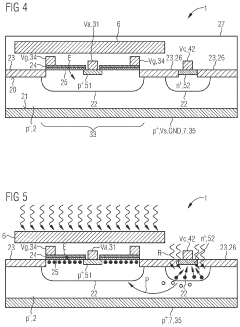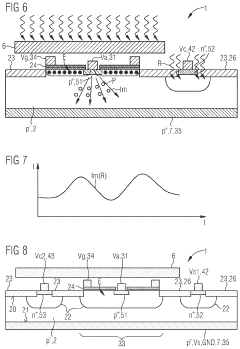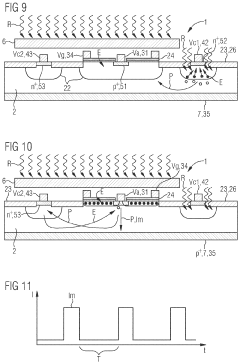Photodiode dynamics in low-light conditions for security systems
AUG 21, 20259 MIN READ
Generate Your Research Report Instantly with AI Agent
Patsnap Eureka helps you evaluate technical feasibility & market potential.
Photodiode Tech Evolution
The evolution of photodiode technology for security systems in low-light conditions has been marked by significant advancements over the past few decades. Initially, photodiodes were primarily used in simple light detection applications, with limited sensitivity and performance in low-light environments.
In the 1980s, the introduction of silicon-based PIN (Positive-Intrinsic-Negative) photodiodes marked a significant milestone. These devices offered improved sensitivity and faster response times compared to their predecessors, making them more suitable for security applications. However, their performance in extremely low-light conditions remained limited.
The 1990s saw the development of avalanche photodiodes (APDs), which provided internal gain through the avalanche effect. This innovation greatly enhanced the ability to detect weak light signals, making them ideal for security systems operating in challenging lighting conditions. APDs allowed for the detection of single photons, revolutionizing low-light imaging capabilities.
The early 2000s brought about the integration of photodiodes with complementary metal-oxide-semiconductor (CMOS) technology. This integration led to the development of CMOS image sensors, which combined the light-sensing capabilities of photodiodes with on-chip signal processing. These sensors offered improved low-light performance and reduced power consumption, making them increasingly popular in security cameras and motion detectors.
In the late 2000s and early 2010s, back-illuminated sensor technology emerged, further enhancing the light-gathering capabilities of photodiodes. By moving the metal wiring behind the photosensitive layer, these sensors could capture more light, significantly improving low-light performance in security applications.
Recent years have seen the development of quantum dot-based photodiodes, which offer enhanced sensitivity across a broader spectrum of light. This technology has the potential to revolutionize night vision capabilities in security systems, allowing for clearer imaging in near-total darkness.
The ongoing miniaturization of photodiodes has also played a crucial role in their evolution. Smaller, more efficient devices have enabled the integration of advanced low-light sensing capabilities into a wide range of security products, from compact surveillance cameras to wearable security devices.
Looking forward, the focus of photodiode technology for security systems is shifting towards improving quantum efficiency, reducing noise, and enhancing dynamic range. Research into novel materials and structures, such as graphene-based photodetectors and organic photodiodes, promises to push the boundaries of low-light detection even further, potentially enabling security systems that can operate effectively in virtually any lighting condition.
In the 1980s, the introduction of silicon-based PIN (Positive-Intrinsic-Negative) photodiodes marked a significant milestone. These devices offered improved sensitivity and faster response times compared to their predecessors, making them more suitable for security applications. However, their performance in extremely low-light conditions remained limited.
The 1990s saw the development of avalanche photodiodes (APDs), which provided internal gain through the avalanche effect. This innovation greatly enhanced the ability to detect weak light signals, making them ideal for security systems operating in challenging lighting conditions. APDs allowed for the detection of single photons, revolutionizing low-light imaging capabilities.
The early 2000s brought about the integration of photodiodes with complementary metal-oxide-semiconductor (CMOS) technology. This integration led to the development of CMOS image sensors, which combined the light-sensing capabilities of photodiodes with on-chip signal processing. These sensors offered improved low-light performance and reduced power consumption, making them increasingly popular in security cameras and motion detectors.
In the late 2000s and early 2010s, back-illuminated sensor technology emerged, further enhancing the light-gathering capabilities of photodiodes. By moving the metal wiring behind the photosensitive layer, these sensors could capture more light, significantly improving low-light performance in security applications.
Recent years have seen the development of quantum dot-based photodiodes, which offer enhanced sensitivity across a broader spectrum of light. This technology has the potential to revolutionize night vision capabilities in security systems, allowing for clearer imaging in near-total darkness.
The ongoing miniaturization of photodiodes has also played a crucial role in their evolution. Smaller, more efficient devices have enabled the integration of advanced low-light sensing capabilities into a wide range of security products, from compact surveillance cameras to wearable security devices.
Looking forward, the focus of photodiode technology for security systems is shifting towards improving quantum efficiency, reducing noise, and enhancing dynamic range. Research into novel materials and structures, such as graphene-based photodetectors and organic photodiodes, promises to push the boundaries of low-light detection even further, potentially enabling security systems that can operate effectively in virtually any lighting condition.
Security System Market Trends
The security system market has been experiencing significant growth and transformation in recent years, driven by increasing concerns about safety and the rapid advancement of technology. This market encompasses a wide range of products and services, including video surveillance, access control, intrusion detection, and integrated security solutions.
One of the key trends shaping the security system market is the growing demand for advanced video surveillance technologies. High-definition cameras, thermal imaging, and low-light sensors are becoming increasingly popular, especially in applications where visibility is crucial in challenging lighting conditions. This trend directly relates to the development of photodiode dynamics in low-light conditions, as improved sensor technology enables better performance in security cameras operating in dimly lit environments.
Another notable trend is the integration of artificial intelligence and machine learning into security systems. These technologies are enhancing the capabilities of video analytics, facial recognition, and anomaly detection, making security systems more proactive and intelligent. The improved processing of low-light imagery, enabled by advancements in photodiode technology, complements this trend by providing clearer input data for AI algorithms to analyze.
The market is also witnessing a shift towards cloud-based security solutions and remote monitoring services. This trend is driven by the need for flexible, scalable, and cost-effective security management, especially for large enterprises and multi-site operations. The ability to transmit and process high-quality video feeds from low-light environments is crucial for the effectiveness of these remote monitoring solutions.
IoT (Internet of Things) integration is another significant trend in the security system market. The interconnectivity of various security devices and sensors is creating more comprehensive and responsive security ecosystems. In this context, the development of more sensitive photodiodes for low-light conditions can enhance the overall effectiveness of IoT-enabled security networks, particularly in outdoor or poorly lit areas.
The market is also seeing increased demand for mobile-compatible security solutions. Users now expect to be able to monitor and control their security systems through smartphones and tablets. This trend emphasizes the importance of high-quality video feeds, even in challenging lighting conditions, to ensure that mobile users can effectively assess security situations remotely.
Lastly, there is a growing focus on energy-efficient and environmentally friendly security solutions. This trend aligns well with the development of more sensitive photodiodes, as they can potentially reduce the need for additional lighting in security applications, thereby lowering energy consumption and operational costs.
One of the key trends shaping the security system market is the growing demand for advanced video surveillance technologies. High-definition cameras, thermal imaging, and low-light sensors are becoming increasingly popular, especially in applications where visibility is crucial in challenging lighting conditions. This trend directly relates to the development of photodiode dynamics in low-light conditions, as improved sensor technology enables better performance in security cameras operating in dimly lit environments.
Another notable trend is the integration of artificial intelligence and machine learning into security systems. These technologies are enhancing the capabilities of video analytics, facial recognition, and anomaly detection, making security systems more proactive and intelligent. The improved processing of low-light imagery, enabled by advancements in photodiode technology, complements this trend by providing clearer input data for AI algorithms to analyze.
The market is also witnessing a shift towards cloud-based security solutions and remote monitoring services. This trend is driven by the need for flexible, scalable, and cost-effective security management, especially for large enterprises and multi-site operations. The ability to transmit and process high-quality video feeds from low-light environments is crucial for the effectiveness of these remote monitoring solutions.
IoT (Internet of Things) integration is another significant trend in the security system market. The interconnectivity of various security devices and sensors is creating more comprehensive and responsive security ecosystems. In this context, the development of more sensitive photodiodes for low-light conditions can enhance the overall effectiveness of IoT-enabled security networks, particularly in outdoor or poorly lit areas.
The market is also seeing increased demand for mobile-compatible security solutions. Users now expect to be able to monitor and control their security systems through smartphones and tablets. This trend emphasizes the importance of high-quality video feeds, even in challenging lighting conditions, to ensure that mobile users can effectively assess security situations remotely.
Lastly, there is a growing focus on energy-efficient and environmentally friendly security solutions. This trend aligns well with the development of more sensitive photodiodes, as they can potentially reduce the need for additional lighting in security applications, thereby lowering energy consumption and operational costs.
Low-Light Sensing Challenges
Photodiodes in security systems face significant challenges when operating in low-light conditions. These challenges primarily stem from the reduced number of photons available for detection, which can lead to decreased signal-to-noise ratios and compromised system performance. One of the main issues is the increased dark current, which is the small electric current that flows through photosensitive devices even when no photons are entering the device. In low-light environments, this dark current can become a significant portion of the total signal, making it difficult to distinguish between actual light detection and background noise.
Another challenge is the reduced responsivity of photodiodes in low-light conditions. As the incident light intensity decreases, the photodiode's ability to generate a measurable electrical signal diminishes, potentially leading to missed detections or false negatives in security applications. This reduced responsivity can be particularly problematic when trying to detect rapid changes in light levels or brief light events, which are often critical in security monitoring scenarios.
Thermal noise also becomes a more prominent issue in low-light sensing. The random motion of charge carriers within the photodiode can generate small currents that are indistinguishable from those produced by actual photon detection. This thermal noise is present at all light levels but becomes more significant relative to the desired signal in low-light conditions, further complicating the detection process.
The dynamic range of photodiodes is also challenged in low-light environments. Security systems often need to operate across a wide range of lighting conditions, from near-total darkness to sudden bright illumination. Maintaining accurate and reliable detection across this range becomes increasingly difficult as the lower end of the light spectrum is approached, requiring sophisticated signal processing and amplification techniques.
Interference from ambient light sources, even if minimal, can pose significant challenges in low-light sensing for security systems. Stray light from distant street lamps, moonlight, or even faint starlight can introduce unwanted signals that must be distinguished from the events of interest. This requires advanced filtering and signal processing algorithms to separate relevant information from background illumination.
Lastly, the physical limitations of semiconductor materials used in photodiodes become more apparent in low-light conditions. The quantum efficiency of these materials, which determines how effectively they can convert incoming photons into electrical signals, may decrease at very low light levels. This fundamental limitation necessitates the exploration of novel materials and device structures to push the boundaries of low-light detection capabilities in security applications.
Another challenge is the reduced responsivity of photodiodes in low-light conditions. As the incident light intensity decreases, the photodiode's ability to generate a measurable electrical signal diminishes, potentially leading to missed detections or false negatives in security applications. This reduced responsivity can be particularly problematic when trying to detect rapid changes in light levels or brief light events, which are often critical in security monitoring scenarios.
Thermal noise also becomes a more prominent issue in low-light sensing. The random motion of charge carriers within the photodiode can generate small currents that are indistinguishable from those produced by actual photon detection. This thermal noise is present at all light levels but becomes more significant relative to the desired signal in low-light conditions, further complicating the detection process.
The dynamic range of photodiodes is also challenged in low-light environments. Security systems often need to operate across a wide range of lighting conditions, from near-total darkness to sudden bright illumination. Maintaining accurate and reliable detection across this range becomes increasingly difficult as the lower end of the light spectrum is approached, requiring sophisticated signal processing and amplification techniques.
Interference from ambient light sources, even if minimal, can pose significant challenges in low-light sensing for security systems. Stray light from distant street lamps, moonlight, or even faint starlight can introduce unwanted signals that must be distinguished from the events of interest. This requires advanced filtering and signal processing algorithms to separate relevant information from background illumination.
Lastly, the physical limitations of semiconductor materials used in photodiodes become more apparent in low-light conditions. The quantum efficiency of these materials, which determines how effectively they can convert incoming photons into electrical signals, may decrease at very low light levels. This fundamental limitation necessitates the exploration of novel materials and device structures to push the boundaries of low-light detection capabilities in security applications.
Current Low-Light Solutions
01 Photodiode response and dynamics
Photodiodes exhibit specific dynamic responses to light stimuli, including rise time, fall time, and frequency response. These characteristics are crucial for various applications, such as high-speed optical communications and precise light detection systems. The dynamics of photodiodes can be optimized through design improvements and material selection to enhance their performance in different operating conditions.- Photodiode response time and dynamics: Photodiodes exhibit specific dynamic behaviors in response to light stimuli. This includes factors such as rise time, fall time, and frequency response. Understanding these dynamics is crucial for optimizing photodiode performance in various applications, particularly in high-speed optical communications and sensing systems.
- Integration of photodiodes in semiconductor devices: Photodiodes are often integrated into complex semiconductor devices and systems. This integration involves considerations of device structure, fabrication processes, and compatibility with other electronic components. Advanced integration techniques can enhance the overall performance and functionality of photodiode-based systems.
- Photodiode array configurations: Photodiode arrays offer enhanced capabilities for light detection and imaging applications. The design and configuration of these arrays impact their performance characteristics, including sensitivity, resolution, and dynamic range. Optimizing array layouts can lead to improved imaging and sensing capabilities in various fields.
- Noise reduction and signal processing in photodiode systems: Enhancing the signal-to-noise ratio is critical in photodiode applications. This involves implementing various noise reduction techniques and signal processing algorithms. Advanced methods can significantly improve the sensitivity and accuracy of photodiode-based measurements and detections.
- Application-specific photodiode designs: Photodiodes are tailored for specific applications such as medical imaging, environmental sensing, and industrial process control. These specialized designs consider factors like spectral response, operating temperature range, and environmental robustness. Customized photodiode configurations can significantly enhance performance in targeted applications.
02 Avalanche photodiode technology
Avalanche photodiodes (APDs) offer high sensitivity and internal gain, making them suitable for low-light detection applications. The dynamics of APDs involve complex processes such as impact ionization and carrier multiplication. Understanding and controlling these dynamics is essential for optimizing APD performance in various fields, including LiDAR systems and quantum communication.Expand Specific Solutions03 Integration of photodiodes in imaging systems
Photodiodes play a crucial role in imaging systems, including CMOS and CCD sensors. The dynamics of these integrated photodiodes affect image quality, sensitivity, and speed. Advancements in pixel design and readout circuitry aim to improve the dynamic range and response time of photodiode-based imaging systems for applications in digital cameras, medical imaging, and machine vision.Expand Specific Solutions04 Photodiode array configurations
Photodiode arrays offer advantages in multi-channel light detection and spatial resolution. The dynamics of these arrays involve considerations such as crosstalk between elements, uniformity of response, and readout speed. Optimizing array configurations and addressing techniques can enhance the overall performance and application range of photodiode-based sensing systems.Expand Specific Solutions05 High-speed photodiode operation
High-speed photodiodes are essential for applications requiring rapid light detection and signal processing. The dynamics of these devices involve factors such as junction capacitance, carrier transit time, and RC time constants. Innovations in materials, device structure, and packaging aim to push the boundaries of photodiode speed for use in optical communications, LiDAR, and scientific instrumentation.Expand Specific Solutions
Key Security System Manufacturers
The photodiode dynamics in low-light conditions for security systems market is in a growth phase, driven by increasing demand for advanced surveillance technologies. The market size is expanding due to rising security concerns across various sectors. Technologically, the field is advancing rapidly, with companies like Sharp Corp., OSI Optoelectronics, and OmniVision Technologies leading innovation. These firms are developing more sensitive photodiodes capable of operating in extremely low-light environments. Other players like NEC Corp. and Sony Group Corp. are also contributing to the technological maturity of the sector, focusing on improving signal-to-noise ratios and reducing power consumption in low-light photodiode applications.
OSI Optoelectronics, Inc.
Technical Solution: OSI Optoelectronics has developed specialized photodiodes for low-light security applications, focusing on enhancing sensitivity and reducing noise. Their approach includes the use of advanced silicon and InGaAs materials to optimize quantum efficiency across different wavelengths, particularly in the near-infrared spectrum commonly used in night vision security systems[10]. The company has implemented proprietary surface passivation techniques to minimize dark current and increase the signal-to-noise ratio in low-light conditions. Additionally, OSI has developed custom packaging solutions that incorporate built-in optical filters and lenses, enhancing overall system performance and simplifying integration into security cameras[11]. Their photodiodes also feature low capacitance designs, enabling faster response times crucial for motion detection in security applications[12].
Strengths: High sensitivity in near-infrared spectrum, low noise performance, and customizable packaging for easy integration. Weaknesses: Potentially higher cost for specialized designs, and may have limitations in extreme low-light conditions compared to more advanced technologies like SiPMs.
OmniVision Technologies, Inc.
Technical Solution: OmniVision has developed specialized image sensors with enhanced photodiode dynamics for low-light security applications. Their approach includes the implementation of large pixel sizes (up to 3.0 μm) with high quantum efficiency, significantly improving light capture in dim conditions[7]. The company has also introduced their proprietary PureCel®Plus-S technology, which utilizes a unique pixel structure to reduce noise and increase sensitivity. This technology incorporates deep trench isolation (DTI) between pixels, minimizing crosstalk and enhancing overall image quality in low-light scenarios[8]. Additionally, OmniVision has implemented advanced on-chip HDR (High Dynamic Range) processing, allowing their sensors to capture clear images in scenes with both very bright and very dark areas simultaneously[9].
Strengths: High sensitivity in low-light conditions, advanced noise reduction, and ability to handle high contrast scenes. Weaknesses: Potential trade-offs between resolution and pixel size, and may require specific software integration for optimal performance.
Innovative Photodiode Designs
High dynamic range, backside-illuminated, low crosstalk image sensor with walls on backside surface to isolate photodiodes
PatentPendingUS20230282671A1
Innovation
- The implementation of a metal grid with dielectric layer on a backside-illuminated image sensor, where the metal grid is aligned over isolation structures and defines apertures over photodiode regions, reducing optical crosstalk by absorption and reflection, and the dielectric layer ensures sensitivity is not affected.
Photodiode and method for operating a photodiode
PatentActiveUS12009439B2
Innovation
- The design of a photodiode with decoupled absorption and amplification regions, where the amplification region is shielded from light absorption using a metal shielding layer, allowing for increased quantum efficiency and minimized noise, and enabling multiple channels with different spectral sensitivities integrated into a single device.
Regulatory Standards for Security Devices
Regulatory standards play a crucial role in ensuring the reliability, safety, and effectiveness of security devices, including those utilizing photodiodes in low-light conditions. These standards are established by various national and international organizations to maintain consistency and quality across the industry.
In the United States, the Federal Communications Commission (FCC) regulates electronic security devices to ensure they do not cause harmful interference to other electronic equipment. The FCC Part 15 rules specifically address unintentional radiators, which include many security devices. Manufacturers must ensure their products comply with these regulations to obtain FCC certification.
The Underwriters Laboratories (UL) is another key organization that develops safety standards for security systems. UL 639, for instance, covers intrusion detection units, including those using photodiodes. This standard outlines requirements for performance, construction, and testing of these devices to ensure they function reliably in various environmental conditions, including low-light scenarios.
Internationally, the International Electrotechnical Commission (IEC) provides standards that are widely recognized. IEC 62642 series covers alarm systems, including intrusion and hold-up systems, which often incorporate photodiode technology. These standards address aspects such as environmental testing, electromagnetic compatibility, and performance criteria for detection devices.
The European Committee for Standardization (CEN) has developed the EN 50131 series of standards for intrusion and hold-up systems. These standards classify security equipment based on environmental conditions and risk levels, providing guidelines for the design, installation, and performance of security devices, including those operating in low-light environments.
In addition to these general standards, specific regulations may apply to photodiodes used in security systems. For example, the IEC 60747-5-2 standard provides specifications for optoelectronic devices, including photodiodes, covering aspects such as electrical characteristics and optical performance.
Compliance with these regulatory standards is not only a legal requirement in many jurisdictions but also ensures that security devices meet minimum performance and safety criteria. Manufacturers must conduct rigorous testing and documentation to demonstrate compliance, often involving third-party certification bodies.
As technology evolves, regulatory standards are periodically updated to address new challenges and capabilities. For instance, the increasing use of artificial intelligence and machine learning in security systems has prompted discussions about potential new standards to ensure the reliability and ethical use of these technologies in conjunction with traditional sensors like photodiodes.
In the United States, the Federal Communications Commission (FCC) regulates electronic security devices to ensure they do not cause harmful interference to other electronic equipment. The FCC Part 15 rules specifically address unintentional radiators, which include many security devices. Manufacturers must ensure their products comply with these regulations to obtain FCC certification.
The Underwriters Laboratories (UL) is another key organization that develops safety standards for security systems. UL 639, for instance, covers intrusion detection units, including those using photodiodes. This standard outlines requirements for performance, construction, and testing of these devices to ensure they function reliably in various environmental conditions, including low-light scenarios.
Internationally, the International Electrotechnical Commission (IEC) provides standards that are widely recognized. IEC 62642 series covers alarm systems, including intrusion and hold-up systems, which often incorporate photodiode technology. These standards address aspects such as environmental testing, electromagnetic compatibility, and performance criteria for detection devices.
The European Committee for Standardization (CEN) has developed the EN 50131 series of standards for intrusion and hold-up systems. These standards classify security equipment based on environmental conditions and risk levels, providing guidelines for the design, installation, and performance of security devices, including those operating in low-light environments.
In addition to these general standards, specific regulations may apply to photodiodes used in security systems. For example, the IEC 60747-5-2 standard provides specifications for optoelectronic devices, including photodiodes, covering aspects such as electrical characteristics and optical performance.
Compliance with these regulatory standards is not only a legal requirement in many jurisdictions but also ensures that security devices meet minimum performance and safety criteria. Manufacturers must conduct rigorous testing and documentation to demonstrate compliance, often involving third-party certification bodies.
As technology evolves, regulatory standards are periodically updated to address new challenges and capabilities. For instance, the increasing use of artificial intelligence and machine learning in security systems has prompted discussions about potential new standards to ensure the reliability and ethical use of these technologies in conjunction with traditional sensors like photodiodes.
Energy Efficiency in Photodiode Systems
Energy efficiency in photodiode systems is a critical consideration for modern security systems, particularly those operating in low-light conditions. The optimization of power consumption in these systems directly impacts their overall performance, operational costs, and environmental footprint. Recent advancements in photodiode technology have led to significant improvements in energy efficiency, enabling the development of more sustainable and cost-effective security solutions.
One of the key strategies for enhancing energy efficiency in photodiode systems is the implementation of advanced power management techniques. These include dynamic power scaling, where the system adjusts its power consumption based on the ambient light conditions. In low-light environments, the photodiode can operate at reduced power levels while maintaining adequate sensitivity, thus conserving energy without compromising performance.
The integration of low-power microcontrollers and signal processing units has also contributed to improved energy efficiency. These components can efficiently manage the photodiode's operation, optimizing power usage during both active and standby modes. Additionally, the use of energy-harvesting technologies, such as photovoltaic cells, can supplement the power supply and extend the operational life of battery-powered security systems.
Advancements in semiconductor materials and fabrication processes have led to the development of photodiodes with higher quantum efficiency and lower dark current. These improvements translate to better signal-to-noise ratios at lower operating voltages, reducing the overall power requirements of the system. Furthermore, the incorporation of nano-scale structures and novel materials like graphene has shown promise in further enhancing the energy efficiency of photodiode systems.
The design of energy-efficient readout circuits plays a crucial role in optimizing the power consumption of photodiode systems. Techniques such as charge integration, correlated double sampling, and adaptive biasing have been employed to minimize power dissipation while maintaining high sensitivity and dynamic range. These circuit-level optimizations are particularly beneficial in low-light conditions, where signal amplification is critical.
In the context of security systems, the implementation of intelligent power management algorithms has proven effective in balancing energy efficiency with system responsiveness. These algorithms can dynamically adjust the photodiode's sampling rate and processing parameters based on detected motion or changes in the environment, ensuring that energy is conserved during periods of inactivity while maintaining rapid response capabilities when needed.
The trend towards miniaturization and integration in photodiode systems has also contributed to improved energy efficiency. Compact, integrated designs reduce parasitic capacitances and resistances, leading to lower power consumption and improved signal integrity. This approach is particularly beneficial for distributed security systems, where multiple low-power nodes can work in concert to provide comprehensive coverage while minimizing overall energy usage.
One of the key strategies for enhancing energy efficiency in photodiode systems is the implementation of advanced power management techniques. These include dynamic power scaling, where the system adjusts its power consumption based on the ambient light conditions. In low-light environments, the photodiode can operate at reduced power levels while maintaining adequate sensitivity, thus conserving energy without compromising performance.
The integration of low-power microcontrollers and signal processing units has also contributed to improved energy efficiency. These components can efficiently manage the photodiode's operation, optimizing power usage during both active and standby modes. Additionally, the use of energy-harvesting technologies, such as photovoltaic cells, can supplement the power supply and extend the operational life of battery-powered security systems.
Advancements in semiconductor materials and fabrication processes have led to the development of photodiodes with higher quantum efficiency and lower dark current. These improvements translate to better signal-to-noise ratios at lower operating voltages, reducing the overall power requirements of the system. Furthermore, the incorporation of nano-scale structures and novel materials like graphene has shown promise in further enhancing the energy efficiency of photodiode systems.
The design of energy-efficient readout circuits plays a crucial role in optimizing the power consumption of photodiode systems. Techniques such as charge integration, correlated double sampling, and adaptive biasing have been employed to minimize power dissipation while maintaining high sensitivity and dynamic range. These circuit-level optimizations are particularly beneficial in low-light conditions, where signal amplification is critical.
In the context of security systems, the implementation of intelligent power management algorithms has proven effective in balancing energy efficiency with system responsiveness. These algorithms can dynamically adjust the photodiode's sampling rate and processing parameters based on detected motion or changes in the environment, ensuring that energy is conserved during periods of inactivity while maintaining rapid response capabilities when needed.
The trend towards miniaturization and integration in photodiode systems has also contributed to improved energy efficiency. Compact, integrated designs reduce parasitic capacitances and resistances, leading to lower power consumption and improved signal integrity. This approach is particularly beneficial for distributed security systems, where multiple low-power nodes can work in concert to provide comprehensive coverage while minimizing overall energy usage.
Unlock deeper insights with Patsnap Eureka Quick Research — get a full tech report to explore trends and direct your research. Try now!
Generate Your Research Report Instantly with AI Agent
Supercharge your innovation with Patsnap Eureka AI Agent Platform!

